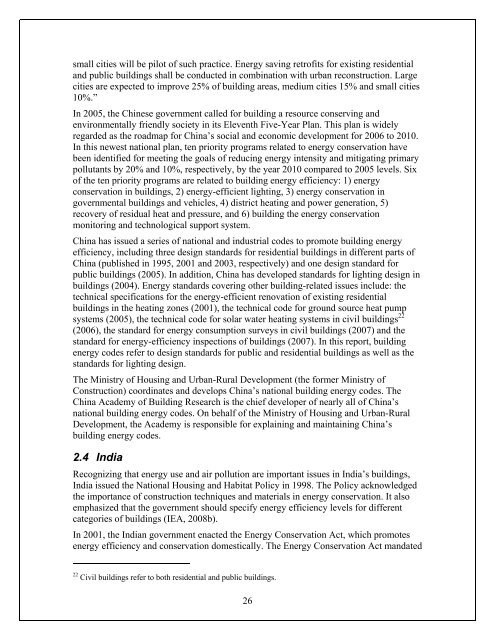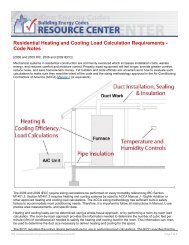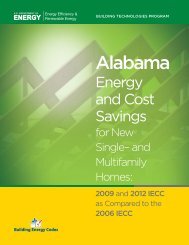small cities will be pilot of such practice. <strong>Energy</strong> sav<strong>in</strong>g retrofits for exist<strong>in</strong>g residentialand public build<strong>in</strong>gs shall be conducted <strong>in</strong> comb<strong>in</strong>ation with urban reconstruction. Largecities are expected to improve 25% of build<strong>in</strong>g areas, medium cities 15% and small cities10%.”In 2005, <strong>the</strong> Ch<strong>in</strong>ese government called for build<strong>in</strong>g a resource conserv<strong>in</strong>g andenvironmentally friendly society <strong>in</strong> its Eleventh Five-Year Plan. This plan is widelyregarded as <strong>the</strong> roadmap for Ch<strong>in</strong>a’s social and economic development for 2006 to 2010.In this newest national plan, ten priority programs related to energy conservation havebeen identified for meet<strong>in</strong>g <strong>the</strong> goals of reduc<strong>in</strong>g energy <strong>in</strong>tensity and mitigat<strong>in</strong>g primarypollutants by 20% and 10%, respectively, by <strong>the</strong> year 2010 compared to 2005 levels. Sixof <strong>the</strong> ten priority programs are related to build<strong>in</strong>g energy efficiency: 1) energyconservation <strong>in</strong> build<strong>in</strong>gs, 2) energy-efficient light<strong>in</strong>g, 3) energy conservation <strong>in</strong>governmental build<strong>in</strong>gs and vehicles, 4) district heat<strong>in</strong>g and power generation, 5)recovery of residual heat and pressure, and 6) build<strong>in</strong>g <strong>the</strong> energy conservationmonitor<strong>in</strong>g and technological support system.Ch<strong>in</strong>a has issued a series of national and <strong>in</strong>dustrial codes to promote build<strong>in</strong>g energyefficiency, <strong>in</strong>clud<strong>in</strong>g three design standards for residential build<strong>in</strong>gs <strong>in</strong> different parts ofCh<strong>in</strong>a (published <strong>in</strong> 1995, 2001 and 2003, respectively) and one design standard forpublic build<strong>in</strong>gs (2005). In addition, Ch<strong>in</strong>a has developed standards for light<strong>in</strong>g design <strong>in</strong>build<strong>in</strong>gs (2004). <strong>Energy</strong> standards cover<strong>in</strong>g o<strong>the</strong>r build<strong>in</strong>g-related issues <strong>in</strong>clude: <strong>the</strong>technical specifications for <strong>the</strong> energy-efficient renovation of exist<strong>in</strong>g residentialbuild<strong>in</strong>gs <strong>in</strong> <strong>the</strong> heat<strong>in</strong>g zones (2001), <strong>the</strong> technical code for ground source heat pumpsystems (2005), <strong>the</strong> technical code for solar water heat<strong>in</strong>g systems <strong>in</strong> civil build<strong>in</strong>gs 22(2006), <strong>the</strong> standard for energy consumption surveys <strong>in</strong> civil build<strong>in</strong>gs (2007) and <strong>the</strong>standard for energy-efficiency <strong>in</strong>spections of build<strong>in</strong>gs (2007). In this report, build<strong>in</strong>genergy codes refer to design standards for public and residential build<strong>in</strong>gs as well as <strong>the</strong>standards for light<strong>in</strong>g design.The M<strong>in</strong>istry of Hous<strong>in</strong>g and Urban-Rural Development (<strong>the</strong> former M<strong>in</strong>istry ofConstruction) coord<strong>in</strong>ates and develops Ch<strong>in</strong>a’s national build<strong>in</strong>g energy codes. TheCh<strong>in</strong>a Academy of Build<strong>in</strong>g Research is <strong>the</strong> chief developer of nearly all of Ch<strong>in</strong>a’snational build<strong>in</strong>g energy codes. On behalf of <strong>the</strong> M<strong>in</strong>istry of Hous<strong>in</strong>g and Urban-RuralDevelopment, <strong>the</strong> Academy is responsible for expla<strong>in</strong><strong>in</strong>g and ma<strong>in</strong>ta<strong>in</strong><strong>in</strong>g Ch<strong>in</strong>a’sbuild<strong>in</strong>g energy codes.2.4 IndiaRecogniz<strong>in</strong>g that energy use and air pollution are important issues <strong>in</strong> India’s build<strong>in</strong>gs,India issued <strong>the</strong> National Hous<strong>in</strong>g and Habitat Policy <strong>in</strong> 1998. The Policy acknowledged<strong>the</strong> importance of construction techniques and materials <strong>in</strong> energy conservation. It alsoemphasized that <strong>the</strong> government should specify energy efficiency levels for differentcategories of build<strong>in</strong>gs (IEA, 2008b).In 2001, <strong>the</strong> Indian government enacted <strong>the</strong> <strong>Energy</strong> Conservation Act, which promotesenergy efficiency and conservation domestically. The <strong>Energy</strong> Conservation Act mandated22 Civil build<strong>in</strong>gs refer to both residential and public build<strong>in</strong>gs.26
<strong>the</strong> creation of <strong>the</strong> Bureau of <strong>Energy</strong> <strong>Efficiency</strong>, which was established under <strong>the</strong>M<strong>in</strong>istry of Power <strong>in</strong> 2002. The <strong>Energy</strong> Conservation Act also authorized Bureau of<strong>Energy</strong> <strong>Efficiency</strong> to establish <strong>the</strong> ECBC.The Bureau of Indian Standards issued National Build<strong>in</strong>g Code of India <strong>in</strong> 2005, whichcovered a range of structural, safety, and o<strong>the</strong>r design issues. <strong>Energy</strong> efficiency wasmarg<strong>in</strong>ally addressed (IEA, 2008b).Under <strong>the</strong> direction of <strong>the</strong> Prime M<strong>in</strong>ister, <strong>the</strong> government’s Plann<strong>in</strong>g Commission issued<strong>the</strong> Integrated <strong>Energy</strong> Policy <strong>in</strong> 2006. This document identifies major areas with largepotential for energy sav<strong>in</strong>gs. Five of <strong>the</strong> 13 areas are related to <strong>the</strong> build<strong>in</strong>gs sector<strong>in</strong>clud<strong>in</strong>g build<strong>in</strong>g design, construction, HVAC, light<strong>in</strong>g and household appliances.In 2007, <strong>the</strong> M<strong>in</strong>istry of Power and Bureau of <strong>Energy</strong> <strong>Efficiency</strong> issued <strong>the</strong> ECBC —<strong>the</strong>first stand-alone national build<strong>in</strong>g energy code <strong>in</strong> India. While it is currently voluntary,ECBC establishes m<strong>in</strong>imum energy efficiency requirements for <strong>the</strong> build<strong>in</strong>g envelope,light<strong>in</strong>g, HVAC, electrical system, water heat<strong>in</strong>g, and pump<strong>in</strong>g systems.2.5 JapanJapan was hit hard by <strong>the</strong> 1973 oil crisis because its oil consumption contributed to 80%of its total primary energy demand at that time. S<strong>in</strong>ce <strong>the</strong>n, <strong>the</strong> Japanese government hasbeen committed to mak<strong>in</strong>g energy efficiency one of its priorities <strong>in</strong> national development.Today, Japan has one of <strong>the</strong> most efficient economies <strong>in</strong> <strong>the</strong> world as measured by energy<strong>in</strong>tensity.Japan’s Rational Use of <strong>Energy</strong>, or <strong>Energy</strong> Conservation Law, was first issued <strong>in</strong> 1979.Initially, it was primarily focused on promot<strong>in</strong>g energy efficiency <strong>in</strong> <strong>the</strong> <strong>in</strong>dustrial sector.The law served as <strong>the</strong> foundation of Japan’s energy efficiency policies and was updatednumerous times <strong>in</strong>clud<strong>in</strong>g <strong>in</strong> 1983, 1993, 1998, 2002, 2005 and 2008 23 . The 2002revision required owners of new commercial build<strong>in</strong>gs larger than 2,000 square meters tosubmit energy sav<strong>in</strong>g plans to <strong>the</strong> government. The 2005 revision, which took effect <strong>in</strong>2006, streng<strong>the</strong>ned energy-efficiency measures for residential build<strong>in</strong>gs and <strong>the</strong>construction sector. Owners of build<strong>in</strong>gs with over 2,000 square meters must submitenergy sav<strong>in</strong>g plans for renovation permits (IEA, 2008c, d, e and f). Recent revisions to<strong>the</strong> <strong>Energy</strong> Conservation Law expand <strong>the</strong> number of build<strong>in</strong>gs for which energy sav<strong>in</strong>gplans are required; <strong>the</strong> revisions go <strong>in</strong>to effect <strong>in</strong> 2009. The revisions require owners ofsmall and medium-sized build<strong>in</strong>gs (from 300 to 2,000 square meters) to submit energysav<strong>in</strong>g plans before construction or renovations beg<strong>in</strong>. Also, construction companiesbuild<strong>in</strong>g more than 150 houses per year need to improve <strong>the</strong> energy performance of <strong>the</strong>houses <strong>the</strong>y build.Under <strong>the</strong> <strong>Energy</strong> Conservation Law, Japan has issued a set of build<strong>in</strong>g energy standardsfor commercial and residential build<strong>in</strong>gs. The Criteria for Clients on <strong>the</strong> Rationalizationof <strong>Energy</strong> Use for Build<strong>in</strong>gs (CCREUB) was first issued <strong>in</strong> 1979, and <strong>the</strong> newest versionwas released <strong>in</strong> 1999 by <strong>the</strong> M<strong>in</strong>istry of International Trade and Industry and <strong>the</strong> M<strong>in</strong>istryof Construction. Two build<strong>in</strong>g energy standards relate to residential build<strong>in</strong>gs: 1) Designand Construction Guidel<strong>in</strong>es on <strong>the</strong> Rationalization of <strong>Energy</strong> Use for Houses23 Part of <strong>the</strong> 2008 version of <strong>the</strong> law will enter <strong>in</strong>to force <strong>in</strong> April 2009 and <strong>the</strong> rema<strong>in</strong>der <strong>in</strong> April 2010.27
- Page 1 and 2: PNNL-122267Shaping the Energy Effic
- Page 3: Shaping the Energy Efficiency in Ne
- Page 6 and 7: efficient air conditioning system,
- Page 8 and 9: ContentsForeword ..................
- Page 10 and 11: List of TablesTable 1 GDP, Primary
- Page 12 and 13: ForewordBuildings account for about
- Page 14 and 15: 1 Introduction and Background1.1 Im
- Page 16 and 17: esidential buildings in 2006, with
- Page 18 and 19: JAP 1. Criteria for Clients on the
- Page 20 and 21: can significantly increase energy d
- Page 22 and 23: f) South Korea’s building energy
- Page 24 and 25: 2.1 AustraliaIn the past, Australia
- Page 28 and 29: (DCGREUH) issued by the Ministry of
- Page 30 and 31: according to the current codes. Thi
- Page 32 and 33: Table 7 Structural Comparison of Bu
- Page 34 and 35: 3.3 Building EnvelopeKey Findings A
- Page 36 and 37: JAPCCREUH1999KORBDCES2008USAASHRAE9
- Page 38 and 39: This study selects the midpoint sco
- Page 40 and 41: MiamiUSA0.36(Insulationabove deck)t
- Page 42 and 43: Six countries have jurisdictions in
- Page 44 and 45: thermal requirements for roofs, flo
- Page 46 and 47: Figure 6 Maximum U-factors in Resid
- Page 48 and 49: Table 16 HVAC in Japan’s Building
- Page 50 and 51: ItemsService water heating refers t
- Page 52 and 53: Water conservation Canada has manda
- Page 54 and 55: practice (MNECB 1997). India sets m
- Page 56 and 57: Canada and India adopt compliance p
- Page 58 and 59: Japan only supervises the building
- Page 60 and 61: 4.2 Testing and RatingKey Findings
- Page 62 and 63: Other commonly used tools among APP
- Page 64 and 65: CAN 55MNECH1997CHNINDECBCJAPCanadia
- Page 66 and 67: and local jurisdiction contact info
- Page 68 and 69: certifying third-party verifiers or
- Page 70 and 71: Point of ControlIncentives for Comp
- Page 72 and 73: Point of ControlIncentives for Comp
- Page 74 and 75: AUS,continuedCANTesting Agencies an
- Page 76 and 77:
CAN,continuedCHNTesting Agencies an
- Page 78 and 79:
Testing Agencies and Certification
- Page 80 and 81:
USA,continuedTesting Agencies and C
- Page 82 and 83:
Appendix C - Compliance SoftwareAUS
- Page 84 and 85:
CANMNECB1997,continuedSoftwareMetho
- Page 86 and 87:
USAIECC 2006,continuedSoftwareMetho
- Page 88 and 89:
AUSBCA 2007,continuedCANMNECB1997CA
- Page 90 and 91:
JAP,ContinuedKORUSAASHRAE90.1-2007T
- Page 92 and 93:
AcronymsAPPAS/NZSASHRAEAUSBATFBCABD
- Page 94 and 95:
ReferencesABCB (Australian Building
- Page 96 and 97:
IEA (International Energy Agency).
- Page 98:
OEE. 2008. Energy Use Data Handbook
















